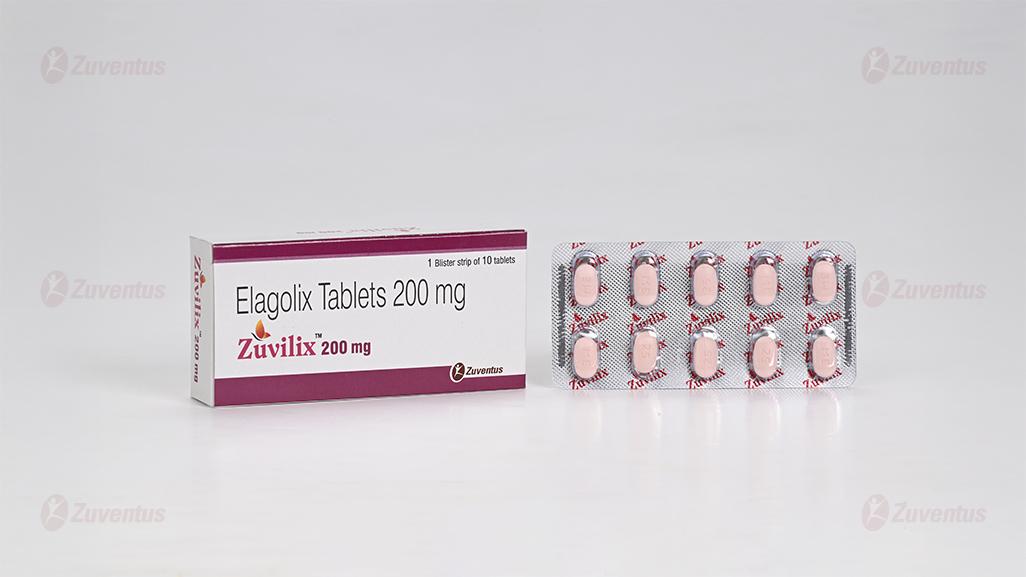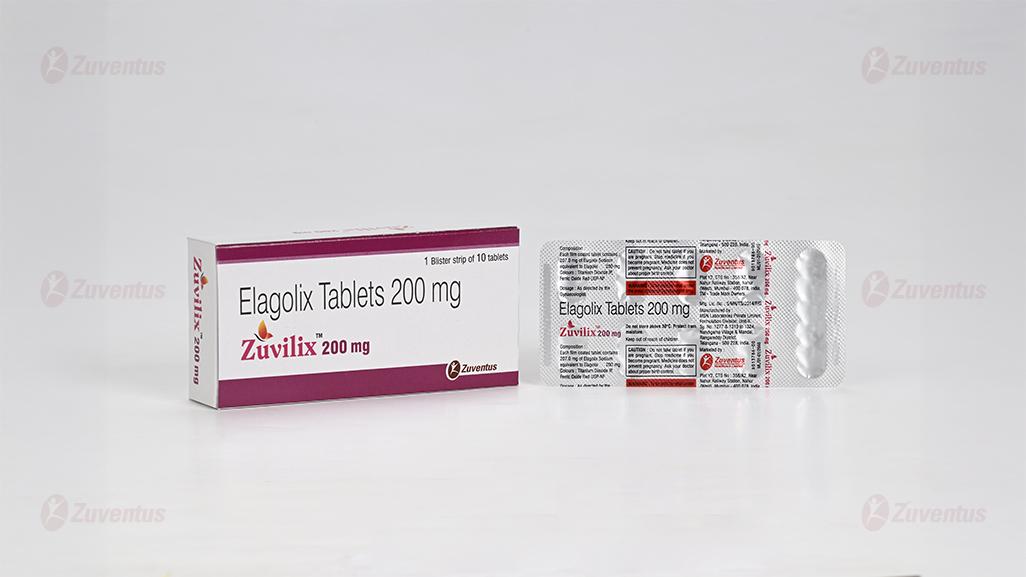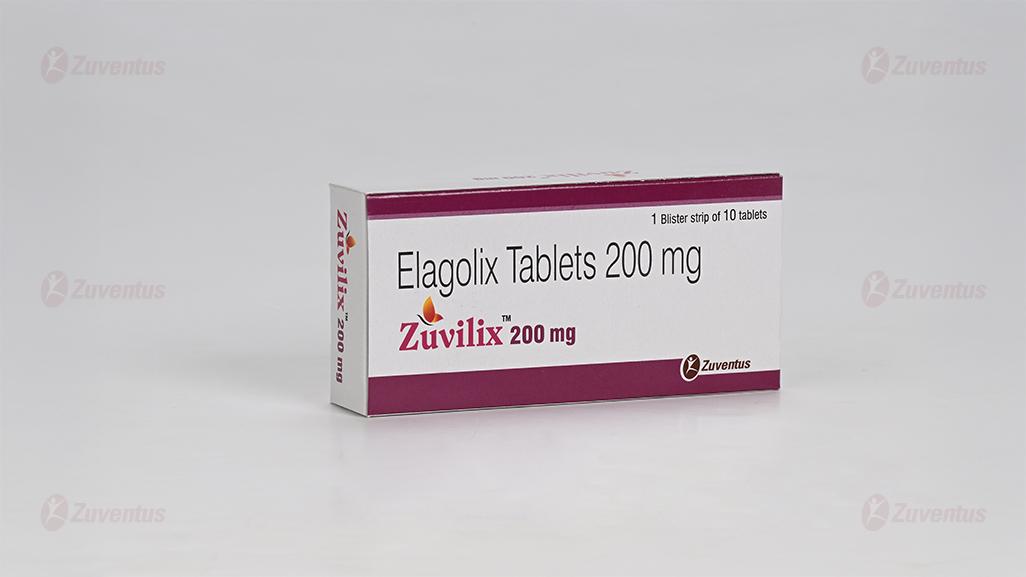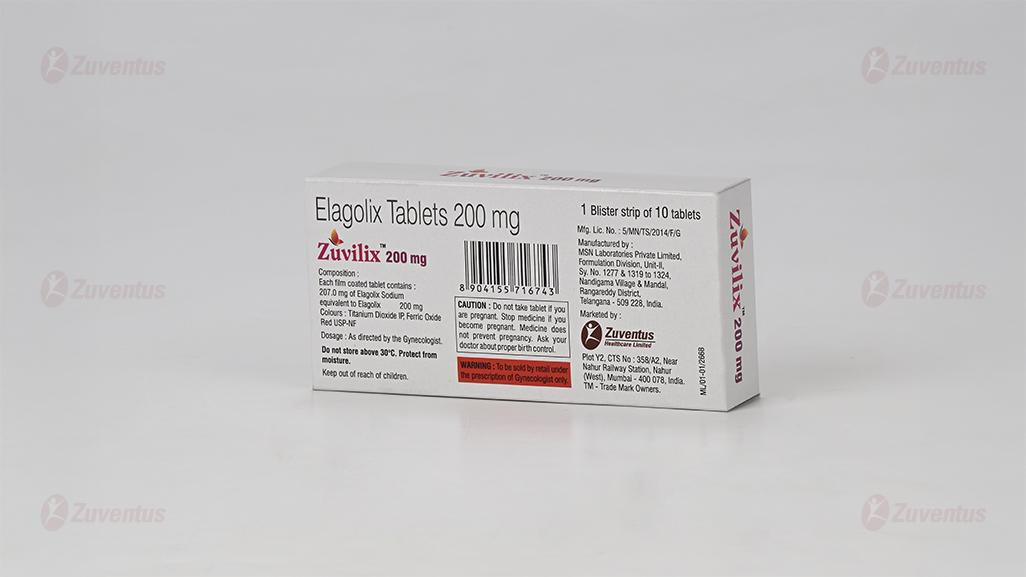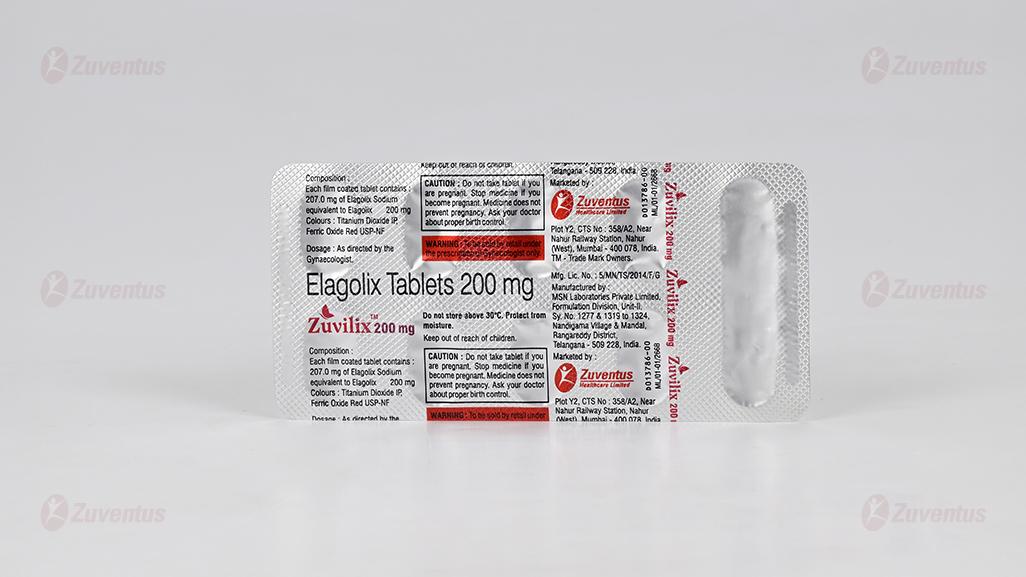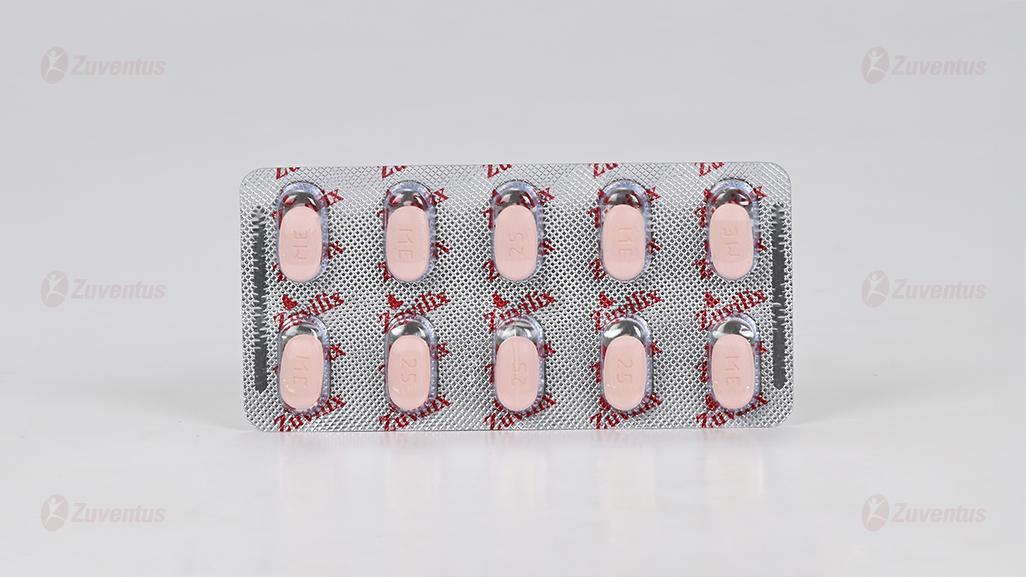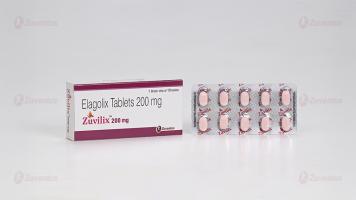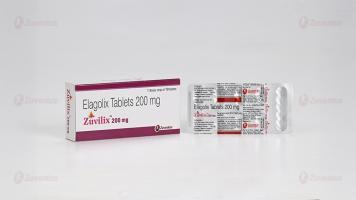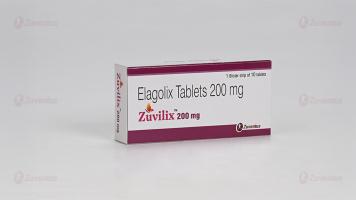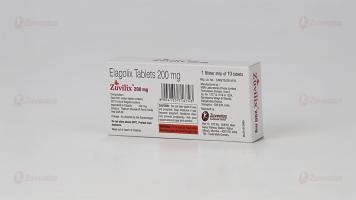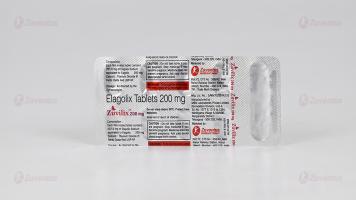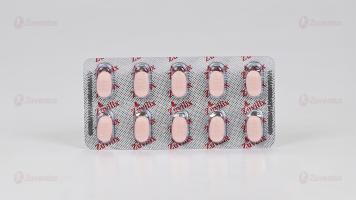Zuvilix Tablets 200mg
Therapy Area
Women's Health
1.0 Generic name
Elagolix Tablets 150 mg / 200 mg
2.0 Qualitative and quantitative composition
Zuvilix 150 mg Each tablet contains :
155.2 mg of Elagolix Sodium
equivalent to Elagolix 150 mg
Colours : Titanium Dioxide IP, FD&C Red #40/, Allura Red AC, Aluminium Lake, FD&C Blue #1/, Brilliant Blue FCF, Aluminium Lake
Zuvilix 200 mg Each tablet contains :
207.0 mg of Elagolix Sodium
equivalent to Elagolix 200 mg
Colours : Titanium Dioxide IP, Ferric Oxide Red USP-NF
3.0 Dosage form and strength
Tablet 150 mg/200 mg
4.0 Clinical particulars
4.1 Therapeutic indications
For the management of moderate to severe pain associated with endometriosis.
4.2 Posology and method of administration
Limitations of use
Limit the duration of use based on the dose and coexisting condition.
Important dosing information
- Exclude pregnancy before starting Zuvilix or start Zuvilix within 7 days from the onset of menses.
- Take Zuvilix at approximately the same time each day, with or without food.
- Use the lowest effective dose, taking into account the severity of symptoms and treatment objectives.
- Limit the duration of use because of bone loss (Table 1).
Table 1. Recommended dosage and duration of use
Renal impairment
No dose adjustment of Zuvilix is required in women with any degree of renal impairment or end-stage renal disease (including women on dialysis).
Hepatic impairment
No dosage adjustment of Zuvilix is required in women with mild hepatic impairment (Child-Pugh A). Compared to women with normal liver function, those with moderate hepatic impairment had approximately 3-fold higher elagolix exposures and those with severe hepatic impairment had approximately 7-fold higher elagolix exposures. Because of these increased exposures and risk for bone loss :
- Zuvilix 150 mg once daily is recommended for women with moderate hepatic impairment (Child-Pugh B) with the duration of treatment limited to 6 months. Use of Zuvilix 200 mg twice daily is not recommended for women with moderate hepatic impairment.
- Zuvilix is contraindicated in women with severe hepatic impairment (Child-Pugh C).
Missed dose
Instruct the patient to take a missed dose of Zuvilix on the same day as soon as she remembers and then resume the regular dosing schedule.
- 150 mg once daily : take no more than 1 tablet each day.
- 200 mg twice daily : take no more than 2 tablets each day.
4.3 Contraindications
- Pregnant. Exposure to elagolix early in pregnancy may increase the risk of early pregnancy loss.
- With known osteoporosis because of the risk of further bone loss.
- Severe hepatic impairment.
- Taking inhibitors of organic anion transporting polypeptide (OATP)1B1 (a hepatic uptake transporter) that are known or expected to significantly increase elagolix plasma concentrations.
- With known hypersensitivity reaction to elagolix or any of its inactive components. Reactions have included anaphylaxis and angioedema.
4.4 Special warnings and precautions for use
Bone loss
Elagolix causes a dose-dependent decrease in bone mineral density (BMD). BMD loss is greater with increasing duration of use and may not be completely reversible after stopping treatment. The impact of these BMD decreases on long-term bone health and future fracture risk are unknown. Elagolix is contraindicated in women with known osteoporosis. Consider assessment of BMD in patients with a history of a low-trauma fracture or other risk factors for osteoporosis or bone loss. Limit the duration of use to reduce the extent of bone loss. Although the effect of supplementation with calcium and vitamin D was not studied, such supplementation may be beneficial for all patients.
Change in menstrual bleeding pattern and reduced ability to recognize pregnancy
Women who take Elagolix may experience a reduction in the amount, intensity or duration of menstrual bleeding, which may reduce the ability to recognize the occurrence of a pregnancy in a timely manner. Perform pregnancy testing if pregnancy is suspected, and discontinue Elagolix if pregnancy is confirmed.
Suicidal ideation, suicidal behaviour, and exacerbation of mood disorders.
Suicidal ideation and behaviour, including one completed suicide, occurred in subjects treated with Elagolix in the endometriosis clinical trials. Elagolix subjects had a higher incidence of depression and mood changes compared to placebo, and Elagolix subjects with a history of suicidality or depression had a higher incidence of depression compared to subjects without such a history. Promptly evaluate patients with depressive symptoms to determine whether the risks of continued therapy outweigh the benets. Patients with new or worsening depression, anxiety or other mood changes should be referred to a mental health professional, as appropriate. Advise patients to seek immediate medical attention for suicidal ideation and behaviour. Re-evaluate the benets and risks of continuing Elagolix if such events occur.
Hepatic transaminase elevations
In clinical trials, dose-dependent elevations of serum alanine aminotransferase (ALT) at least 3- times the upper limit of the reference range occurred with Elagolix. Use the lowest effective dose of Elagolix and instruct patients to promptly seek medical attention in case of symptoms or signs that may reflect liver injury, such as jaundice. Promptly evaluate patients with elevations in liver tests to determine whether the benefits of continued therapy outweigh the risks.
Interactions with hormonal contraceptives
Advise women to use effective non-hormonal contraceptives during treatment with Elagolix and for 28 days after discontinuing Elagolix. Increase in Estrogen Exposure and Potential Associated Increased Risks When Elagolix 200 mg Twice Daily is Taken with Combined Hormonal Contraceptives.
Potential for reduced efficacy of progestin-containing hormonal contraceptives
Co-administration of Elagolix 200 mg twice daily and a COC containing 0.1 mg levonorgestrel decreases the plasma concentrations of levonorgestrel by 27%, potentially affecting contraceptive efficacy. Co-administration of Elagolix with COCs containing norethindrone acetate did not show a reduction in plasma concentrations of norethindrone.
Reduced efficacy of Elagolix
Based on the mechanism of action of Elagolix, estrogen-containing contraceptives are expected to reduce the efficacy of Elagolix. The effect of progestin-only contraceptives on the efficacy of Elagolix is unknown.
4.5 Drugs interactions
Potential for Elagolix to affect other drugs
Elagolix is :
- A weak to moderate inducer of cytochrome P450 (CYP) 3A. Co-administration with Elagolix may decrease plasma concentrations of drugs that are substrates of CYP3A (see Table 2).
- A weak inhibitor of CYP 2C19. Co-administration with Elagolix may increase plasma concentrations of drugs that are substrates of CYP2C19 (see Table 2).
- An inhibitor of efux transporter P-glycoprotein (P-gp). Co-administration with Elagolix may increase plasma concentrations of drugs that are substrates of P-gp (see Table 2).
The effects of co-administration of Elagolix on concentrations of concomitant drugs and the clinical recommendations for these drug interactions are summarized in Table 2.
Table 2. Drug interactions : Effects of Elagolix on other drugs
Potential for other drugs to affect Elagolix
Elagolix is a substrate of CYP3A, P-gp, and OATP1B1. Concomitant use of Elagolix 200 mg twice daily and strong CYP3A inhibitors for more than 1 month is not recommended. Limit concomitant use of Elagolix 150 mg once daily and strong CYP3A inhibitors to 6 months. Co-administration of Elagolix with strong CYP3A inducers may decrease Elagolix plasma concentrations and may result in a decrease of the therapeutic effects of Elagolix. Concomitant use of Elagolix 200 mg twice daily and rifampin is not recommended. Limit concomitant use of Elagolix 150 mg once daily and rifampin to 6 months. The effect of concomitant use of P-gp inhibitors or inducers on the pharmacokinetics of Elagolix is unknown. OATP1B1 inhibitors that are known or expected to signicantly increase Elagolix plasma concentrations are contraindicated due to increased risk of Elagolix associated adverse reactions.
4.6 Use in special populations (such as pregnant women, lactating women, paediatric patients, geriatric patients etc.)
Pregnancy
Use of Elagolix is contraindicated in pregnant women. Exposure to Elagolix early in pregnancy may increase the risk of early pregnancy loss. Discontinue Zuvilix if pregnancy occurs during treatment.
Lactation
There is no information on the presence of Elagolix or its metabolites in human milk, the effects on the breastfed child, or the effects on milk production. There are no adequate animal data on the excretion of Elagolix in milk. The developmental and health benefits of breastfeeding should be considered along with the mother’s clinical need for Elagolix and any potential adverse effects on the breastfed child from Elagolix.
Females and males of reproductive potential
Based on the mechanism of action, there is a risk of early pregnancy loss if Elagolix is administered to a pregnant woman.
Pregnancy Testing
Elagolix may delay the ability to recognize the occurrence of a pregnancy because it may reduce the intensity, duration, and amount of menstrual bleeding. Exclude pregnancy before initiating treatment with Elagolix. Perform pregnancy testing if pregnancy is suspected during treatment with Elagolix and discontinue treatment if pregnancy is confirmed.
Contraception
Advise women to use effective non-hormonal contraception during treatment with Elagolix and for 28 days after discontinuing Elagolix.
Pediatric use
Safety and effectiveness of Elagolix in pediatric patients have not been established.
4.7 Effects on ability to drive and use machines
Zuvilix is unlikely to affect the ability to drive and use machines as it is not distributed in the central nervous system.
4.8 Undesirable effects
The following serious adverse reactions are reported Bone loss, change in menstrual bleeding pattern and reduced ability to recognize pregnancy, suicidal ideation, suicidal behaviour, and exacerbation of mood disorders, hepatic transaminase elevations, hot flush, headache, nausea, insomnia, anxiety, mood altered, mood swings, amenorrhea, depressed mood, depression, depressive symptoms and/or tearfulness, appendicitis, abdominal pain, back pain, arthralgia, libido, diarrhoea, abdominal pain, weight gain, dizziness, constipation, irritability
Reporting of suspected adverse reactions
Reporting suspected adverse reactions after authorization of the medicinal product is important. It allows continued monitoring of the benefit / risk balance of the medicinal product. Healthcare professionals are asked to report any suspected adverse reactions via email to : medico@zuventus.com
Website : https://www.zuventus.com/drug-safety-reporting By reporting side effects, you can help provide more information on the safety of this medicine.
4.9 Overdose
In case of overdose, monitor the patient for any signs or symptoms of adverse reactions and initiate appropriate symptomatic treatment, as needed.
5.0 Pharmacological properties
5.1 Mechanism of action
Elagolix is a GnRH receptor antagonist that inhibits endogenous GnRH signaling by binding competitively to GnRH receptors in the pituitary gland. Administration of Elagolix results in dosedependent suppression of luteinizing hormone (LH) and follicle-stimulating hormone (FSH), leading to decreased blood concentrations of the ovarian sex hormones, estradiol and progesterone.
5.2 Pharmacodynamic properties
Effect on Ovulation and Estradiol In a 3-menstrual cycle study in healthy women, Elagolix 150 mg once daily and 200 mg twice daily resulted in an ovulation rate of approximately 50% and 32%, respectively. In the Phase 3 trials in women with endometriosis, Elagolix caused a dose-dependent reduction in median estradiol concentrations to approximately 42 pg/mL for 150 mg once daily regimen and 12 pg/mL for the 200 mg twice daily regimen.
Cardiac Electrophysiology
The effect of Elagolix on the QTc interval was evaluated in a randomized, placebo- and positive-controlled, open-label, single-dose, crossover thorough QTc study in 48 healthy adult premenopausal women. Elagolix concentrations in subjects given a single dose of 1200 mg was 17-times higher than the concentration in subjects given Elagolix 200 mg twice daily. There was no clinically relevant prolongation of the QTc interval.
5.3 Pharmacokinetic properties
The pharmacokinetic properties of Elagolix in healthy subjects are summarized in Table 3. Table 3. Pharmacokinetic Properties of Elagolix in Healthy Subjects
6.0 Nonclinical properties
6.1 Animal toxicology or pharmacology
Carcinogenesis, mutagenesis, impairment of fertility
Two-year carcinogenicity studies conducted in mice (50, 150, or 500 mg/kg/day) and rats (150, 300, or 800 mg/kg/day) that administered Elagolix by the dietary route revealed no increase in tumors in mice at up to 19-fold the MRHD based on AUC. In the rat, there was an increase in thyroid (male and female) and liver (males only) tumors at the high dose (12 to 13-fold the MRHD). The rat tumors were likely species-specic and of negligible relevance to humans. Elagolix was not genotoxic or mutagenic in a battery of tests, including the in vitro bacterial reverse mutation assay, the in vitro mammalian cell forward mutation assay at the thymidine kinase (TK+/-) locus in L5178Y mouse lymphoma cells, and the in vivo mouse micronucleus assay. In a fertility study conducted in the rat, there was no effect of Elagolix on fertility at any dose (50, 150, or 300 mg/kg/day). Based on AUC, the exposure multiple for the MRHD in women compared to the highest dose of 300 mg/kg/day in female rats is approximately 5-fold. However, because Elagolix has low afnity for the GnRH receptor in the rat and because effects on fertility are most likely to be mediated via the GnRH receptor, these data have low relevance to humans.
7.0 Description
Zuvilix tablets for oral administration contain elagolix sodium, the sodium salt of the active moiety elagolix. Elagolix sodium is a non-peptide small molecule GnRH receptor antagonist.
Elagolix sodium is chemically described as sodium 4-({(1R)-2-[5-(2-fluoro-3- methoxyphenyl)-3-{[2-fluoro-6-(trifluoromethyl)phenyl]methyl}-4-methyl-2,6-dioxo-3,6- dihydropyrimidin-1(2H)-yl]-1- phenylethyl}amino)butanoate.
Elagolix sodium has a molecular formula of C32H29F5N3O5Na and a molecular weight of 653.58
8.0 Pharmaceutical particulars
8.1 Incompatibilities
Not applicable
8.2 Shelf-life
Refer on the pack.
8.3 Packaging information
PVC-Alu blister strip of 10 tablets.
8.4 Storage and handling instructions
Do not store above 30°C. Protect from moisture.
Keep out of reach of children.
9.0 Patient counseling information
Bone Loss
Inform patients about the risk of bone loss. Advise patients that supplementary calcium and vitamin D may be beneficial if dietary intake of calcium and vitamin D is not adequate.
Change in Menstrual Bleeding Pattern, Contraception and Pregnancy
Advise women that Zuvilix may delay the recognition of pregnancy because it may reduce the amount, intensity, or duration of menstrual bleeding. Advise patients to use effective non-hormonal contraception while taking Zuvilix and to discontinue Zuvilix if pregnancy is confirmed. Advise pregnant women that there is a pregnancy registry that monitors outcomes in women who become pregnant while treated with Zuvilix.
Suicidal ideation, suicidal behaviour, and exacerbation of mood disorders
Advise patients that suicidal ideation and exacerbation of mood disorders may occur with Zuvilix use. Instruct patients to seek immediate medical attention for suicidal ideation and behaviour and for new onset or worsening depression, anxiety, or other mood changes.
Liver injury
Advise patients to promptly seek medical attention in case of signs or symptoms that may reflect liver injury, such as jaundice.
Zuvilix missed dose instructions
Instruct a patient who miss a dose of Zuvilix to take the missed dose on the same day as soon as she remembers and then resume the regular dosing schedule :
- 150 mg once daily : no more than 1 tablet each day should be taken.
- 200 mg twice daily : no more than 2 tablets each day should be taken.
11.0 Details of permission or license number with date
5/MN/TS/2014/F/G dated 16 November 2024
12.0 Date of issue
16 January 2025
About Leaflet
Read all of this leaflet carefully before you start taking this medicine because it contains important information for you.
- Keep this leaflet. You may need to read it again.
- If you have any further questions, ask your doctor or pharmacist.
- This medicine has been prescribed for you only. Do not pass it on to others. It may harm them, even if their signs of illness are the same as yours.
- If you get any side effects, talk to your doctor or pharmacist. This includes any possible side effects not listed in this leaflet.
What is in this leaflet
- What Zuvilix Tablet is and what it is used for
- What you need to know before you take Zuvilix Tablet
- How to take Zuvilix Tablet
- Possible side effects
- How to store Zuvilix Tablet
- Contents of the pack and other information
1. What Zuvilix Tablet is and what it is used for
Zuvilix has a medicine called Elagolix sodium. It helps reduce moderate to severe pain caused by endometriosis, a condition where tissue similar to the lining inside the uterus grows outside it.
2. What you need to know before you take Zuvilix Tablet
Do not take Zuvilix if you:
- You are pregnant or think you might be pregnant.
- You have osteoporosis (weak bones).
- You have severe liver problems.
- You are taking certain medicines that affect how your liver works.
- You are allergic to elagolix or any other ingredients in the medicine.
Warnings and precautions:
Bone Loss
- Zuvilix can make your bones weaker over time, and this might not fully get better after you stop taking it.
- The longer you use it; the more bone loss you might have.
- The long-term effects on bone health and fracture risk are not known.
- Do not use Zuvilix if you have osteoporosis (weak bones).
- Your doctor might check your bone health if you have a history of fractures or other risk factors.
- Limit how long you use Zuvilix to reduce bone loss.
- Taking calcium and vitamin D might help, but this hasn't been studied.
Changes in Menstrual Bleeding and Pregnancy Recognition
- Zuvilix can change your menstrual bleeding, making it lighter or shorter.
- This might make it harder to know if you are pregnant.
- If you think you might be pregnant, take a pregnancy test and stop Zuvilix if you are pregnant.
Suicidal Thoughts and Mood Changes
- Some people taking Zuvilix have had suicidal thoughts or behaviour, including one person who died by suicide.
- People taking Zuvilix had more depression and mood changes than those taking a placebo.
- If you have a history of depression or suicidal thoughts, you might be more likely to have these issues with Zuvilix.
- If you feel depressed or have mood changes, talk to your doctor to see if you should continue taking Zuvilix.
- Seek immediate medical help if you have suicidal thoughts or behaviour.
Liver Problems
- Zuvilix can cause increases in liver enzymes, which might indicate liver damage.
- Use the lowest effective dose and see a doctor if you have symptoms of liver problems, like jaundice (yellowing of the skin or eyes).
- Your doctor will check your liver tests to decide if you should keep taking Zuvilix.
Interactions with Hormonal Contraceptives
- Use non-hormonal birth control while taking Zuvilix and for 28 days after stopping it.
- Taking Zuvilix with combined hormonal contraceptives (like birth control pills) can increase estrogen levels and related risks.
- Zuvilix can reduce the effectiveness of some hormonal contraceptives.
- The effect of progestin-only contraceptives on Zuvilix is not known.
Pregnancy
Use of Elagolix is contraindicated in pregnant women. Exposure to Elagolix early in pregnancy may increase the risk of early pregnancy loss. Discontinue Zuvilix if pregnancy occurs during treatment.
Lactation
The developmental and health benefits of breastfeeding should be considered along with the mother’s clinical need for Elagolix and any potential adverse effects on the breastfed child from Elagolix.
Females and males of reproductive potential
Based on the mechanism of action, there is a risk of early pregnancy loss if Elagolix is administered to a pregnant woman.
Pregnancy Testing
Elagolix may delay the ability to recognize the occurrence of a pregnancy because it may reduce the intensity, duration, and amount of menstrual bleeding. Exclude pregnancy before initiating treatment with Elagolix. Perform pregnancy testing if pregnancy is suspected during treatment with Elagolix and discontinue treatment if pregnancy is confirmed.
Contraception
Advise women to use effective non-hormonal contraception during treatment with Elagolix and for 28 days after discontinuing Elagolix.
Pediatric use
Safety and effectiveness of Elagolix in pediatric patients have not been established.
Driving and using machines:
Zuvilix is unlikely to affect the ability to drive and use machines as it is not distributed in the central nervous system.
How Elagolix Affects Other Medications
Digoxin (for heart problems): Elagolix can increase digoxin levels. Your doctor should monitor digoxin levels and watch for signs of toxicity.
Midazolam (a sedative): Elagolix can lower midazolam levels. Your doctor might need to increase the dose of midazolam.
Rosuvastatin (for cholesterol): Elagolix can lower rosuvastatin levels. Your doctor should monitor your cholesterol and adjust the dose if needed.
Omeprazole (for acid reflux): Elagolix can increase omeprazole levels. No dose change is needed for 40 mg daily, but higher doses might need adjustment.
Hormonal Contraceptives (like birth control pills): Elagolix can increase estrogen and decrease progestin levels. Use non-hormonal birth control methods during and for 28 days after stopping Elagolix.
How Other Medications Affect Elagolix
Strong CYP3A Inhibitors (like some antibiotics and antifungals): These can increase Elagolix levels. Use Elagolix 150 mg once daily for up to 6 months. Do not use Elagolix 200 mg twice daily with these drugs.
Strong CYP3A Inducers (like some seizure medications): These can decrease Elagolix levels, making it less effective. Use Elagolix 150 mg once daily for up to 6 months. Do not use Elagolix 200 mg twice daily with these drugs.
OATP1B1 Inhibitors (like some cholesterol medications): These can significantly increase Elagolix levels. Do not use Elagolix with these drugs due to the risk of side effects.
General Recommendations
Non-Hormonal Contraceptives: Use non-hormonal birth control methods while taking Elagolix and for 28 days after stopping it.
Monitoring: Regularly check drug levels and how well the medications are working when taking Elagolix with other drugs.
3. How to take Zuvilix Tablet
Always take this medicine exactly as your doctor has told you. Check with your doctor or pharmacist if you are not sure.
How to Take Zuvilix
- Before Starting: Make sure you are not pregnant before you start taking Zuvilix. If you are starting Zuvilix, do so within 7 days from the start of your period.
- Daily Routine: Take Zuvilix at the same time every day. You can take it with or without food.
- Dosage: Use the lowest dose that works for you. Your doctor will decide the right dose based on your symptoms.
- Duration: Do not use Zuvilix for too long because it can cause bone loss. Follow your doctor's instructions on how long to take it.
Recommended Dosages
- 150 mg once daily: You can take this dose for up to 24 months.
- 200 mg twice daily: This dose is for severe pain during intercourse (dyspareunia) and can be taken for up to 6 months.
Moderate Liver Problems:
Women with moderate liver problems have higher levels of the drug in their body. They should take 150 mg once daily for up to 6 months. They should not take the 200 mg dose twice daily.
Kidney Problems (Renal Impairment)
No Change Needed: Women with any level of kidney problems, including those on dialysis, do not need to change their dose of Zuvilix.
Liver Problems (Hepatic Impairment)
Mild Liver Problems: Women with mild liver problems do not need to change their dose of Zuvilix.
Severe Liver Problems: Women with severe liver problems should not take Zuvilix at all because of the high levels of the drug and the risk of bone loss.
Missed Dose
If you miss a dose, take it as soon as you remember on the same day. Then continue with your regular schedule.
- 150 mg once daily: Do not take more than 1 tablet each day.
- 200 mg twice daily: Do not take more than 2 tablets each day.
If you have any further questions on the use of this product, ask your doctor or pharmacist.
4. Possible side effects
The following serious adverse reactions are reported
Bone loss, change in menstrual bleeding pattern and reduced ability to recognize pregnancy, suicidal ideation, suicidal behaviour, and exacerbation of mood disorders, hepatic transaminase, elevations, hot flush, headache, nausea, insomnia, anxiety, mood altered, mood swings, amenorrhea, depressed mood, depression, depressive symptoms and/or tearfulness, appendicitis, abdominal pain, back pain, arthralgia, libido, diarrhoea, abdominal pain, weight gain, dizziness, constipation, irritability
Reporting of side effects
If you get any side effects, talk to your doctor, pharmacist or nurse. This includes any possible side effects not listed in this leaflet. You can also report side effects directly:
Website: www.zuventus.com and click the tab “Safety Reporting” located on the top end of the home page.
Website link: https://www.zuventus.com/drug-safety-reporting
By reporting side effects, you can help provide more information on the safety of this medicine. You can also report the side effect with the help of your treating physician.
5. How to store Zuvilix Tablet
Do not store above 30°C. Protect from moisture.
Keep out of reach of children.
6. Contents of the pack and other information
What Zuvilix contains:
- The active ingredient is Elagolix Sodium.
- Other ingredients include Titanium Dioxide IP, FD&C Red #40/, Allura Red AC, Colours: Titanium Dioxide IP, Ferric Oxide Red USP-NF
What Zuvilix looks like and contents of the pack:
- Zuvilix comes in tablet form in strengths of 150 mg, and 200 mg.
- The tablets are packed in a PVC-Alu blister strip of 10 tablets.
This leaflet was last revised on: 12 March 2025

